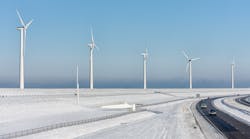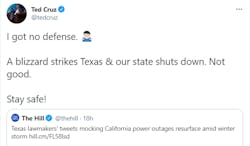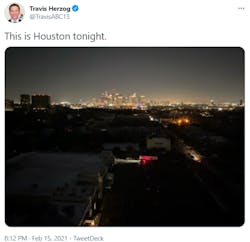Blackout Misconceptions: People on Social Media Become Overnight Power Experts
With the lights going out in Texas, Appalachia and some Great Plains states, people are taking to social media to connect with others, share tips and simply get some idea of how bad these power outages are going to be.
Because it’s social media though, there is a lot of low-quality information out there that either misunderstands the situation or just flat doesn’t know how electricity works.
Here’s a guide to some of the misinformation we’ve seen floating around the internet.
1. Power conservation is not a partisan issue
Texas Sen. Ted Cruz was taken to task on Twitter about his past comments on California officials encouraging people to use as little electricity as possible when that state was struggling with a hot weather and wildfires. At the time, Cruz tweeted Aug. 19, 2020, “California is now unable to perform even basic functions of civilization, like having reliable electricity… Hope you don’t like air conditioning!”
To his credit, Cruz responded to people needling him for saying this months before a similar crisis happened in his home state by apologizing.
“I got no defense. A blizzard strikes Texas & our state shuts down. Not good. Stay safe!” Cruz tweeted Wednesday in response to a story about his past tweets.
The thing is, when the power supply is tight, utilities, regional grid operators and state governments will call for power conservation. Whether supplies are tight because of a freezing winter storm, a heat wave or a natural disaster, it’s just a good idea not to overload the grid during these times.
That’s why these warnings about using too much power go out at such times. It’s not a Republican thing or a Democrat thing. It’s a physics thing. If there is too much strain on the grid, an unbalanced condition exists and an uncontrolled power outage could result. Electricity does not care who you voted for. It simply follows the laws of physics.
2. Blaming the problem on wind turbines
Texas is a top state for both wind power and solar generation according to US Energy Information Administration (EIA). EIA also reports Texas uses more energy than any other state. It produces more electricity from wind turbines than any other state and set a record of nearly 20 GW of wind generation in January 2019.
Since the winter storm, subzero temperatures and the power outages that followed, there have been viral posts on social media that blame power outages on wind turbines “freezing up,” but in reality, only a fraction of the electricity needed was planned to be generated by the wind.
Social media accounts circulated pictures of frozen wind turbines, including one from a wind farm in Sweden, to criticize the “green energy agenda.” This is despite the fact Texas is a deregulated market that mostly operates off its own power grid outside the oversight of the federal government. Texas has run its own power grid since 1970 when ERCOT got started, but more about that later.
“If the last few days have proven anything, it’s that we need oil & gas,” tweeted George P. Bush, who as Texas Land Commissioner oversees much of the state’s oil and gas production. “Relying solely on renewable energy would be catastrophic. Many of these sources have proven to be unreliable.”
The fact is, just about every way we have of making and distributing electricity performs worse under subzero conditions experienced when we are not prepared for them. And that is what happened to the middle of the country this week.
Thermal power plants, whether they use coal, natural gas or nuclear to spin their turbines all have to use water pumped through pipes to run their condensers and control their internal temperatures. If the plants are not insulated against low temperatures, as many are not in the Southern US, they become less safe to operate and must sometimes shut down.
Also, the batteries that make energy storage possible are less efficient in temperature extremes, losing as much as half their storage capacity. Extreme cold can damage the strength of a transmission line conductor, which can lead to a host of problems if not designed for the temperatures.
The other side of it is that cold temperatures result in more electricity demand, so at this time when both power generation and power transmission are stressed out, people need more electricity to heat their homes. This is a recipe for a power outage, and it is nonsense to blame any one part of our electricity system for floundering during extreme weather conditions when the fact is cold makes powering cities more difficult across the board. It’s not rocket science, just attention to details.
3. What’s causing these outages anyway?
A variety of social media posts are getting it wrong on the facts of these blackouts. They blame power companies or politicians or the weather. What’s missing is context.
Many of the power outages happening in the US right now are the result of the biggest cause of power outages: Line contacts or breaks because of severe weather. Simply put, ice has weighed a line down and caused it to snap a power pole or the line itself and it cuts an area off from the power supply. Or else a tree, caked and weighed down by ice, snaps a branch and downs the line.
These are probably the most classic causes of power outages, and they are why utilities spend millions every year on vegetation management or tree trimming — so that when a tree limb falls, it isn’t one that contacts a line.
In Texas, the problem is less that lines are down and more that power plants are. According to a 2019 report, about 47.4% of ERCOT's generation was natural gas fired, which was impacted by moisture in the gas freezing and causing pumping problems.
ERCOT ordered utilities to shed gigawatts of load, and those utilities responded by taking parts of their power grid offline on a rotating basis, but there was a problem with the rotation. There isn’t much of a choice with so much power generation struggling to produce needed power. If utilities and grid operators do not bring load centers (neighborhoods, industries, businesses, etc.) offline, the grid could become strained and even worse, more widespread outages could result.
If a piece of a power grid fails, load will automatically shift to other, nearby elements of the grid and that piece of the grid, in turn, will become overloaded. This starts a chain reaction called a cascading power failure. A power failure of this type struck the Northeast United States and some Canadian provinces in 2003, cutting off power to millions when it should have only been a much smaller, more manageable outage.
By taking some customers offline, Texas is trying to stave off further damage until it can correct the cause of the load curtailments: the beleaguered power plants. Fortunately, ERCOT announced Wednesday morning that it could restore some 3,500 MW of load, or about 700,000 average households.
However, when a city is gripped in a power crisis, grid operators and utilities do have to make difficult decisions.
4. Why do we have big empty office buildings lit in the middle of town, but neighborhoods in the dark?
Photos of downtown areas like Kansas City, Dallas and Houston have circulated on social media asking why we have large skyscrapers lit up while neighborhoods full of people are living in the dark. A valid question especially while many offices are letting people work from home during a pandemic. We know there are a lot more people in those darkened homes than in those brightly lit buildings downtown.
This is an example of common sense winning out. Utilities do have to make choices during times of forced power curtailment, so it is completely fair to ask why a grid operator or utility made a particular choice. In a time of rolling blackouts, it’s only natural to ask why more power isn’t flowing to the people.
And in fact, since such posts have gone viral, power supplies in some communities have shifted toward neighborhoods instead of downtown areas. Kansas City, for one example, darkened their skyline after criticism from the internet.
Compounding the issue, there was no direction given to utilities from ERCOT on these blackouts, resulting in the problem of lots of customers sitting in the dark for days while others had power.
5. Why does Texas struggle with insufficient power?
As pointed out earlier, cold weather is not good for power plants or the power grid. Everything is worse under extremely cold conditions. However, we do have colder areas of the country that manage to operate their power plants and deliver power just fine.
Texas has been hit this week with below zero temperatures and has seen summers with extended periods of 100-plus degrees. That’s a big temperature swing for power engineers to contend with. Up north where the mercury dips below zero more often, power plants are hardened against the cold with insulative technology. In states with warmer weather, generation owners must do a cost-benefit analysis and decide whether they want to invest in winterization measures or risk power plants going offline in extreme weather. There was a gamble made, and customers were hurt when the wrong number came up.
Another way Texas is different than the rest of the country is the deregulation alluded to earlier in the story. Texas made a conscious decision to deregulate its power system and allow independent power marketers. It offered electricity customers the choice to choose between a variety of electricity providers. Of course, when there is no power, “electricity choice” becomes meaningless, and worse if the only supplier was charging $9,000 megawatt- hour.
Under the deregulation regime, power producers are separate from utilities. In other economic structures, utilities often own their own plants or power lines. Generators are therefore powerfully financially incentivized to produce only as much power as they can sell and no more. Most publicly owned power companies find it worth their while to operate some reserve power generation in case of an emergency. But in Texas, if generators miss that target, they lose money making excess power.
Economics is one reason Texas often struggles to have enough power during severe hot or cold weather. If power companies were incentivized to generate more power than is usually needed, those unusual times would go more smoothly. And with a changing climate, we are certainly seeing more unusual times than we are used to.





